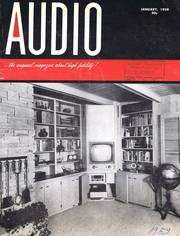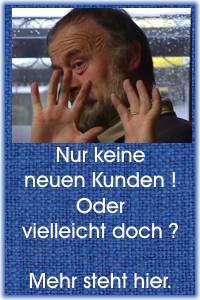Erläuterungen zu diesen US-AUDIO Seiten der 1950er Jahre
Die hier stehenden amerikanischen Artikel aus 1959 (aus der US-AUDIO) sind teilweise sehr gewöhnungsbedürftig, weil sie erstens aus einer längst vergangenen Zeit stammen und zweitens, weil dort in den USA ganz "anders" gedacht wurde als bei uns in Old Germany oder in Europa.
Vergleichbar mit unseren deutschen Hifi-Magazinen etwa ab 1962 ist jedoch, daß auch dieses Audio-Magazin ihre Anzeigen- Kunden und -Leser am Markt oder von anderen Magazinen (be- oder ab- ?) werben mußte. - Weiterhin sind die riesigen Dimensionen des amerikanischen Kontinents mit unseren hier in Europa nicht vergleichbar. - Ein Redaktions-"Trip" von New York nach Los Angeles oder Chicago oder gar in die Wüste nach Las-Vegas zu einer der CES- Audio- "Shows" war - auch mit dem Flugzeug - immer noch eine halbe Weltreise. Und jede Ausstellung oder "Messe" wurde als "Show" deklariert. Und natürlich, in USA musste alles "Show" sein, um beim Publikum einige Aufmerksamkeit zu erzeugen.
.
ABOUT MUSIC - "As The Expression Goes . . ."
von HAROLD LAWRENCE1
During the reign of Louis Philippe, an amateur choral society founded by the Prince de la Moskowa gave some eccentric performances of the works of Giovanni Pierluigi da Palestrina (Anmerkung : lebte etwa 1525 bis 1594). "It was their custom," wrote Saint-Saens, "to sing the greater parts of these pieces pianissimo and with extreme slowness, so that in the long-held passages the singers had to be divided, some of them carrying on the sound when others had exhausted their breath."
Although a few musicians grumbled at the absurd treatment, the mid-19th century public as a whole accepted it complacently. Palestrina, after all, had left nothing to guide future interpreters but the notes themselves; and the Prince, detained by no indications of pace, dynamics, and phrasing, gave free reign to his "imagination."
Had Palestrina been born half a century later, the Prince might not have dared to turn the Italian composer's music into a breathing marathon. But it was not until the middle of the 17th century that the expression mark became universally adopted. The verbal notations which musicians employed constituted a simple language : speed was indicated then as now by such terms as adagio, allegro, vivace; volume by piano, forte, etc.
Italian won out over French and English as the language of "expression" due to the wide distribution of Italian madrigals in the early part of the century.
Brauchte man wirklich soviele Expressions ?
There was no reason for the Baroque composer to sprinkle his music with additional expression marks. Apart from the essentials of tempo and intensity, his music clearly dictated its own expressive course.
Expression marks were therefore utilized only to avoid possible ambiguity. (Bach dispensed with them altogether in the Well-Tempered Clavier.) Even tempo markings were often omitted when the composer felt their inclusion superfluous.
The modern interpreter need only follow J. C. Bach's sound advice in his book, Essay on the True Art of Playing Keyboard Instruments, to do the right thing by the Baroque repertoire: "The pace of a composition . . . is based on its general content as well as the fastest notes and passages contained in it. Due consideration of these factors will prevent an allegro from being rushed and an adagio from being dragged."
Choice of tempo is also dictated by the place in which the work is performed - and this applies obviously to all forms and periods of music. To secure the utmost clarity, one must adjust the speed to the hall's acoustical properties. One of the reasons church performances are generally unsatisfactory is that the performer rarely takes into consideration the long reverberation period.
Allegro, piano and forte, gegenüber non troppo, sempre legato, p dolce,
The vocabulary of "expression" grew along with the development of instrumental and orchestral music. Where, for example, a page of a keyboard work by Bach might contain such indications as Allegro, piano and forte, a page of Beethoven might be filled with the following markings: Vivace ma non troppo, sempre legato, p dolce,
Adagio espressivo, and a liberal assortment of pianos, fortes, crescendos and diminuendos. Note the embellishment of certain basic designations: vivace ma non troppo; p dolce; adagio espressivo. In a letter written in 1817, Beethoven spoke of those "headings, inherited from times of musical barbarism, by which we describe the tempo of a movement.
What, for example, can be more absurd than 'allegro' which, once and for all, means 'cheerful'? How far removed we often are from the meaning! How often a piece of music expresses the very opposite of its heading! . I have often thought of giving up those absurd words allegro, andante, adagio, presto."
Beethoven never carried out his threat to abandon Italian terms, though he amplified the headings with such words as appassionato, molto cantabile, espressivo, and so on. The linguistic revolution he hoped for was brought about instead by the Romantic composers who, spurred on by nationalistic impulses, reverted to their native tongues. An outcome of this movement was greater freedom of vocabulary and more detailed indications.
Gegenüberstellung Percy Grainger und Italien
In more recent times, one of the most colorful advocates of the "national" expression mark is Percy Grainger. Virtually all of Grainger's indications are written in a sort of open-air English that turns the standard Italian markings into vapid symbols. Here is a partial list of Grainger's expressions with their traditional counterparts :
Gegenüberstellung
| Grainger | Italian |
| louden | crescendo |
| feelingly | espressivo |
| soften and slacken | dim. e rit. |
| louden lots | molto crescendo |
| louden hugely | molto crescendo |
| don't soften | non dim. |
| slow off | rit. |
| slow off lots | molto rit. |
| shortish | mezzo staccato |
| quicken | accelerando |
Wie Grainger die Instrumente benannte :
Not content to substitute his own expressions marks for the Italian, Grainger has also focused his attention on the names of instruments. In his orchestral scores, violins are "fiddles," violas "middle-fiddles," cellos "bass-fiddles," and percussion instruments of definite pitch "tuneful percussion."
There are only remote Italian translations for the following Grainger instructions : "With Healthy and somewhat fierce 'go' ", and "wrenched forte."
Few composers have displayed as much consideration for the lowly instrumentalist as did Grainger in his Lincolnshire Posy. At the bottom of one page he wrote, "The flügelhorn or soprano saxophone soloist may, if he likes, use his own expression marks, in place of those printed."
Moussorgsky's Pictures at an Exhibition
Along with the flowering of the Romantic Era came a certain verbal extravagance, which often confronts the performer with some rather interesting musical challenges. A case in point is Moussorgsky's Pictures at an Exhibition.
One particular phrase is marked poco ritard con dolore. As R. W. Wood pointed out in his article on expression (Music & Letters, Oct. 1930), "If the pianist duly regards the poco ritard, the piano, the <>, the sf and the slurs it is virtually impossible for him to do anything further ..... If con dolore (dolefully) results, well and good, if not, the performer is not to blame."
Other examples mentioned by Mr. Wood include Holbrooke's "Moving exorably, grim, and prodded," Debussy's "this rhythm must have the sonic value of a sad and frozen landscape," Wagner's many zarts (tender), and Elgar's nobil-mentes (nobly). "All they actually convey," concludes Mr. Wood, "is how the passage in question always sounds to the composer himself."
Eigentlich ist eine Expresson überflüssig
But is it that simple? According to this line of reasoning, of what possible value to the player is the unscientific nobilmente?
Would the conductor approach the score any differently if it were not there? What specific ingredient does it call for? Logically speaking, it is a superfluous marking.
Can we dismiss it however because it fails to concern itself with isolated points of tempo, dynamics, touch, phrasing, bowing, and other technical details? It is true, of course, that a sensitive performer will probably ferret out the expression inherent in a given musical work, with or without the "fringe markings.
But what Mr. Wood calls the "loose-thinking" expression mark nevertheless serves a thoughtful and far from loose purpose. The appearance of a zart or a nobilmente at a certain point in the score, perhaps underlining a cello theme or accompanying a sudden shift in dynamic values, should alert the performer and suggest to him that the composer attaches a special meaning to the passage in question, one that could not be conveyed by the traditional marking.
In plain words, the composer hopes to put the performer in the mood. No one blames the conductor who supplements his stick technique with a large repertoire of facial expressions, gestures, and even choreography of a sort, so long as the ultimate result is a great performance. Why then should not the composer employ unusual verbal means to obtain a deeper understanding of his intentions?
The inevitable outcome of the growth of the expression mark in the 19th century was its abuse, not only by composers, but by publishers of older music. Editions of Bach, Beethoven and Mozart appeared in print containing markings in such profusion that it was sometimes difficult to see the notes for the marks. Early 20th-century Erik Satie satirized the "over-expressive" score in his own music by filling his pages with such whimsical instructions as:
Ne tournez pas (Don't turn)
Grattez (Scratch)
Souriez (Smile)
Ne parlez pas (Don't speak)
Igor Stravinsky, whose own scores are models of clarity, has some cogent thoughts to offer on the subject of the expression mark : "No matter how scrupulously a piece of music may be notated, no matter how carefully it may be insured against every possible ambiguity through the indications of tempo, shading, phrasing, accentuation, and so on, it always contains hidden elements that defy definition, because verbal dialectic is powerless to define musical dialectic in its totality."
This, of course, is where the interpreter takes over; it is his task to respond to the directions implied in a musical work, using the expression mark merely as a valuable guidepost.
.



